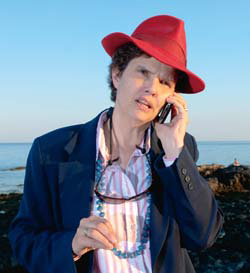Oil spills in temperate waters like the 2010 Deepwater Horizon disaster in the Gulf of Mexico are bad enough. But spills in the Arctic would be even worse, according to a well-known oil hazards researcher who spoke this winter at the annual meeting of the American Association for the Advancement of Science. What’s more, the risk posed by tankers in the cold, vulnerable north is about to intensify from an expected surge in Russian oil shipments through the Bering Strait starting this summer, said Nancy Kinner.
Strategic partnerships between academia and the federal government are beneficial when spills occur. Kinner codirects one such partnership, the Coastal Response Research Center, a collaboration between the University of New Hampshire (UNH) and the National Oceanic and Atmospheric Administration.
Kinner, a professor of civil and environmental engineering at UNH in Durham, gave a talk at the meeting about the use of chemicals to disperse oil released by the Deepwater Horizon rig and other challenges of responding to oil spills. When that industrial disaster gushed out millions of gallons of crude oil and gases into waters of the Gulf of Mexico, responders used a controversial chemical dispersant, applied to the ocean surface and beneath the surface at the oil well, to assist the cleanup process.
Dispersants help break up the oil into smaller clumps, which are easier for ocean bacteria to digest, but they pose their own dangers. Until the Deepwater Horizon incident, the largest U.S. marine oil spill, dispersants were used on only a few spills on a much smaller scale. Now new research on dispersant droplets finds just how small they can get, revealing another danger for spill responders.
After her talk, Kinner set aside her signature red hat and sat down with SciCom's Laura G. Shields for a wide-ranging interview. (Her responses below have been edited for length and clarity.) She discussed with us the current level of oil spill risk—from Russian activities and otherwise, the response options that companies and governments have when spills occur, some new and major findings about the size and danger of dispersant droplets, and her thoughts about oil spills and the future.
There are no cookie-cutter solutions for the problems of preventing and combating oil spills, Kinner said. Instead, she emphasized, “each spill is unique, and every day of that spill is unique.”
For the full interview with Nancy Kinner, please see this story by Laura G. Shields in Eos, the news magazine of the American Geophysical Union.
_______________
Laura G. Shields publishes a slick collection of stories at www.lauragshields.com.

